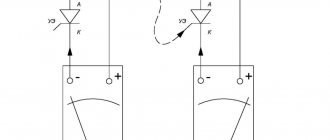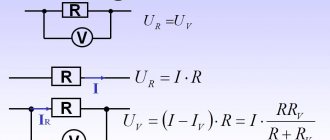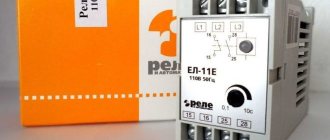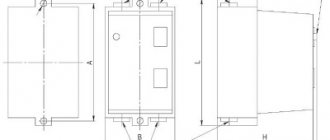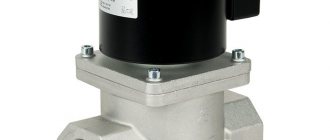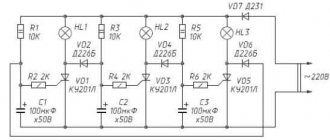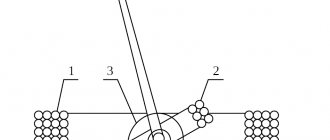Varistors are semiconductor devices whose resistance decreases sharply (by several orders of magnitude) when the voltage applied to them exceeds a certain threshold value. This feature of these devices determines their use in systems for protecting electrical circuits from overvoltage (by connecting a varistor in parallel to the protected circuit). The current-voltage characteristic of varistors is symmetrical, so they limit the voltage regardless of its polarity, including the ability to operate in alternating voltage circuits.
As a rule, they are metal oxide or zinc oxide. If you look at the current-voltage characteristics of a varistor, you can note that it has a nonlinear symmetrical shape, that is, it can operate not only on direct voltage, but also on alternating voltage. Such an element is connected parallel to the load. How does a varistor work?
When the voltage in the network increases, the current does not pass through the equipment, but through the varistor. Such a device is capable of distributing energy in the form of heat. Its main features are its repeated use and fast recovery time, meaning its resistance is the same when the tension is removed.
What is the operating principle of a varistor? The part is no different from a regular resistor, that is, during normal operation of the electronics, it has an ohmic resistance. So, let's look at the operating principle of a varistor.
The indicator of such resistance is quite high, and can be 100,000 Ohms. When the voltage is turned on, it may decrease as soon as the need for level protection arises. The resistance drops from 100,000 ohms to 100. If the value drops to low or zero, a short circuit may occur. In this case, the fuse, which is located in the electrical circuit in front of the varistor, fails. After this, the electrical circuit is closed and the voltage is completely turned off.
As mentioned earlier, in the absence of voltage, the varistor can be completely restored and operate in its previous mode. For it to function, you need to replace the blown fuse. The electronic device will then function correctly. A varistor is connected in parallel to the power source. Let's look at the operating principle of a varistor using the example of a regular personal computer. Since it has two terminals, the connection is carried out in parallel with phase and zero.
How is a varistor marked?
Today you can find different designations for these devices. Each manufacturer has the right to install it independently. The markings differ because the technical characteristics of varistors differ from each other. Examples include such indicators as the permissible voltage or the required current level.
Currently, each manufacturer sets its own labeling for these types of devices. This is explained by the fact that the devices produced have different technical characteristics. For example, the maximum permissible voltage or the current level required for operation. The most popular marking is CNR, to which a designation such as 07D390K is attached. What does this mean? So, the CNR designation itself indicates the type of device. In this case, the varistor is metal oxide.
Further, 07 is the size of the device in diameter, that is, equal to 7 mm. D is a disk device, and 390 is the maximum allowable voltage.
Marking, main characteristics and parameters
Each varistor manufacturer labels its product in a certain way, so there are quite a large number of designation options and their interpretations. The most common Russian varistor is K275, and popular foreign-made components are 7n471k, kl472m and others.
The designation of the CNR-10d751k varistor can be deciphered as follows: CNR – metal oxide varistor; d – means that the component is disk-shaped; 10 is the diameter of the disk; 751 – response voltage for this device (calculation is done by multiplying the first two digits by 10 to the power equal to the third digit, that is, 75 multiplied by 10 to the first power, you get 750 V); k is the permissible deviation of the rated voltage, which is equal to 10% in any direction (l – 15%, M – 20%, P – 25%).
Diagnostics
To test this electronic device, special equipment called a tester is used. So, to carry out the test you will need a varistor, the principle of which is to change the resistance parameters, and a testing device. Before you start, you need to turn on the device and switch to resistance mode. Only then will the device meet all the necessary technical requirements, and the amount of resistance will be enormous.
Before starting testing, it is necessary to check the technical condition of the device. First of all, you should look at its appearance. The device should not show any cracks or signs that it has burned out. You should not inspect the device negligently, as any minor breakdown can lead to unpleasant circumstances.
Varistor selection
To choose the right varistor for a particular device, you need to know the characteristics of its power source: resistance and transient pulse power. The maximum permissible current value is determined, among other things, by the duration of its influence and the number of repetitions, therefore, if you install a varistor with a low peak current value, it will quickly fail. In short, to effectively protect the device it is necessary to choose a varistor with a voltage that has a small margin to the rated one.
Also, for the trouble-free operation of such an electronic component, the rate of dissipation of absorbed thermal energy and the ability to quickly return to a state of normal operation are very important.
Varistors: application
Such devices play an important role in human life.
From all of the above, we can say that a varistor, the principle of which is to protect electronics from high voltage in the network, helps prevent the breakdown of many electrical appliances and maintain the integrity of the wiring. The main location is electrical circuits in various equipment. For example, they are found in lighting starting elements, which are also called ballasts. Special varistors are also installed in electrical circuits, the use of which is necessary to stabilize voltage and current.
Such devices are also used in power lines. But there they are called dischargers, the operating voltage of which is more than twenty thousand volts.
Varistors can operate over a wide voltage range, which starts from a very small value of 3 V and ends at 200 V. As for the element current, the range is from 0.1 to 1 A. Such current indicators are valid only for low-voltage technical equipment .
Types and principle of operation
Semiconductor resistors are classified by voltage, since their scope of application depends on this. There are only 2 types:
- High voltage with operating voltage up to 20 kV.
- Low voltage, the voltage of which is in the range from 3 to 200 V.
All of them are used to protect circuits from overloads: the first - to protect electrical networks, electrical machines and installations; the latter serve to protect radio components in low-voltage circuits. The operating principle of varistors is the same and does not depend on its type.
In the initial state it has high resistance, but when the rated voltage value is exceeded, it drops. As a result of this, according to Ohm's law for a section of a circuit, the current value increases as the resistance value decreases. The varistor operates in zener diode mode. When designing a device and for its correct operation, one should take into account the capacitance of the varistor, the value of which is directly proportional to the area and inversely proportional to its thickness.
In order to correctly select an element for protection against overloads in the power supply circuits of a device, you should know the value of the source resistance at the input, as well as the power of the pulses generated during switching. The maximum value of current passed by the varistor determines the duration and repetition period of surges of amplitude voltage values.
Positive aspects of varistors
This type of device has many positive qualities when compared with other devices, for example, with a spark gap. These important advantages include:
- high speed of the element;
- the ability to monitor current drops using an inertia-free method;
- possibility of use at voltage levels ranging from 12 to 1800 V;
- long service life;
- relatively low cost due to the simplicity of the design.
Advantages and disadvantages of varistors
Important advantages of a nonlinear resistor (varistor) are its stable and reliable operation with high frequencies and heavy loads. It is used in many devices operating with voltages from 3 V to 20 kV, is relatively simple and cheap to produce and is effective in operation. Additional important benefits are:
- high response speed (nanoseconds);
- long service life;
- ability to monitor voltage drops (inertia-free method).
Despite the fact that this electronic component has many advantages, it also has disadvantages that affect its use in various systems. These include:
- low-frequency noise during operation;
- component aging (loss of parameters over time);
- high capacity: depends on the voltage and type of element, ranges from 70 to 3200 pF and affects the performance of the device;
- at maximum voltage values, power is not dissipated - it overheats significantly and fails at prolonged maximum voltage values.
Negative sides
Along with so many advantages over other devices, there are also significant disadvantages, among which are the following.
- Varistors have a huge capacitance, which affects the operation of the electrical network. This indicator can range from 80 to 3000 pF. It depends on many points: the design and type of varistor, as well as the maximum voltage level. It is worth noting that in some cases such a significant drawback can turn into a major advantage. But this is possible quite rarely, for example, if you use a varistor in filters. In such a situation, a large capacitance will serve as a voltage limiter in the network.
- Compared to arresters, varistors are not able to dissipate power at maximum voltage levels.
To increase the scattering rate, it is necessary to increase the size of the elements, which is what many manufacturers are doing.
What is a varistor and where is it used?
A varistor is a variable resistor made of semiconductor material that is capable of changing its electrical resistance depending on the voltage applied to it.
The operating principle of such an electronic component differs from a conventional resistor and potentiometer. A standard resistor has a constant resistance value at any time, regardless of the voltage in the circuit; a potentiometer allows you to change the resistance manually by turning the control knob. But the varistor has a nonlinear symmetrical current-voltage characteristic and its resistance completely depends on the voltage in the circuit.
Thanks to this property, varistors are widely and effectively used to protect electrical networks, machines and equipment, as well as radio-electronic components, boards and microcircuits, regardless of the type of voltage. They have a low manufacturing price, are reliable in use and can withstand high loads.
Varistors are used both in high-voltage installations up to 20 kV, and in low-voltage installations from 3 to 200 V as a voltage limiter. Moreover, they can operate both in networks with alternating and direct current. They are used to regulate and stabilize current and voltage, as well as in overvoltage protective devices. They are used in the design of surge protectors, power supplies, mobile phones, SPDs and other SPS.
Recommendations for installation
If there is a need to connect a varistor to the electrical network, you need to remember the following important points:
- You should always keep in mind that this device will not last forever, and conditions will arise that will lead to its explosion. To prevent this from happening, it is necessary to use special protective screens in which the entire varistor can be placed.
- It should be noted that flint technical devices are significantly inferior in their characteristics to their oxide analogues. Therefore, it is best to use this type of varistor.
Marking and main parameters
The marking of varistors is different, since each manufacturer of these radio components has the right to install it independently. This is primarily due to its technical characteristics. For example, differences in voltages and required current levels for its operation.
You might be interested in The design of a thermocouple, its types and operating principle
Among domestic ones, the most common is K275, and among imported ones - 7n471k, 14d471k, kl472m and ac472m. The most popular is a varistor, the marking of which is CNR (there are also hel, vdr, jvr). In addition, the alphanumeric index 14d471k is attached to it, and this type of designation is deciphered as follows:
- CNR - metal oxide type.
- 14 - device diameter equal to 14 mm.
- D is a disc-shaped radio component.
- 471 is the maximum voltage value for which it is designed.
- K is the permissible deviation of the classification voltage equal to 10%.
There are technical specifications required for application in the circuit. This is because different types of semiconductor resistance must be used to protect different circuit elements.
Their main characteristics:
- Classification voltage is the value of the potential difference, taken into account that a current of 1 mA flows through the varistor.
- The maximum value of the alternating voltage is the rms value at which it opens and, therefore, the value of its resistance decreases.
- The constant maximum voltage value at which the varistor opens in a DC circuit. As a rule, it is greater than the previous parameter for a current of variable amplitude.
- The permissible voltage (limitation voltage) is the value above which the element fails. Indicated for a specific current value.
- The maximum energy absorbed is measured in J (joules). This characteristic shows the amount of pulse energy that a varistor can dissipate and not fail.
- Response time (unit - nanoseconds, ns) - the value required to transition from one state to another, that is, a change in resistance value from a high value to a low value.
- Classification voltage error is a deviation from its nominal value in both directions, which is indicated in % (for imported models: K = 10%, L = 15%, M = 20% and P = 25%).
After describing the operating principle, marking features and main characteristics, the scope of application of varistors should be considered.

